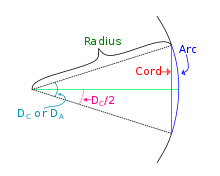Degree of curvature
Degree of curve or degree of curvature is a measure of curvature of a circular arc used in civil engineering for its easy use in layout surveying.
Definition
The degree of curvature is defined as the central angle to the ends of an arc or chord of agreed length.[1] Various lengths are commonly used in different areas of practice. This angle is also the change in forward direction as that portion of the curve is traveled.
Usage
Curvature is usually measured in radius of curvature. A small circle can be easily laid out by just using radius of curvature, But if the radius is large as a km or a mile, degree of curvature is more convenient for calculating and laying out the curve of large scale works like roads and railroads. By this method curve setting can be easily done with the help of a transit or theodolite and a chain, tape or rope of a prescribed length.
In an n-degree curve, the forward bearing changes by n degrees over the standard length of arc or chord. The usual distance in North American road work is 100 feet (30.48 m) of arc.[2] North American railroad work traditionally used 100 feet of chord and this may be used in other places for road work. Other lengths may be used—such as 30 metres or 100 metres where SI is favoured, or a shorter length for sharper curves. Where degree of curvature is based on 100 units of arc length, the conversion between degree of curvature and radius is Dr = 18000/π ≈ 5729.57795, where D is degree and r is radius.
As an example, a curve with an arc length of 600 units that has an overall sweep of 6 degrees is a 1-degree curve: For every 100 feet of arc, the bearing changes by 1 degree. The radius of such a curve is 5729.57795. If the chord definition is used each 100-unit chord length will sweep 1 degree with a radius of 5729.651 units, and the chord of the whole curve will be slightly shorter than 600 units.
Since rail routes have very large radii, they are laid out in chords, as the difference to the arc is inconsequential and this made work easier before electronic calculators became available.
The 100 feet (30.48 m) is called a station, used to define length along a road or other alignment, annotated as stations plus feet 1+00, 2+00 etc. Metric work may use similar notation, such as kilometers plus meters 1+000.
Formulas for radius of curvature
Degree of curvature can be converted to radius of curvature by the following formulae:

Formula from arc length
where is arc length, is radius of curvature and is degree of curvature, arc definition
Formula from chord length
where is chord length, is radius of curvature and is degree of curvature, chord definition
Formula from radius
See also
- Geometric design of roads
- Highway engineering
- Lateral motion device
- Minimum railway curve radius
- Radius of curvature (applications)
- Railway systems engineering
- Track geometry
- Track transition curve
- Transition curve
- Turning radius
References
- Wolf and Ghilani. Elementary Surveying, 11th ed., 2006
- Davis, Foote, and Kelly. Surveying Theory and Practice, 1966
External links
Note the variation in usage among these samples.
- https://web.archive.org/web/20050212195231/http://du.edu/~jcalvert/railway/degcurv.htm
- http://www.tpub.com/content/engineering/14071/css/14071_242.htm
- https://web.archive.org/web/20050223171348/http://www.steamlocomotive.com/model/curve.html
- http://www.cee.mtu.edu/~balkire/ce3401tc/ce3401Lec20.doc
- http://www.trainweb.org/freemoslo/Modules/Tips-and-Techniques/degrees_of_curve.htm
- https://web.archive.org/web/20041213192255/http://www.fairview-industries.com/standardmodule/circurve.htm *https://web.archive.org/web/20050304064535/http://ceprofs.tamu.edu/rbruner/curves/circularcrvs.htm
- http://www.memun.org/SchoolsProject/html/Resources/Roads/Fundamentals.htm%5B%5D
- https://web.archive.org/web/20040917090858/http://www.cityoffrederick.com/departments/Planning/APPENDIX_C_SUBDIVISION_REGULATIONS/Sec__5__Final_subdivision_plat.html